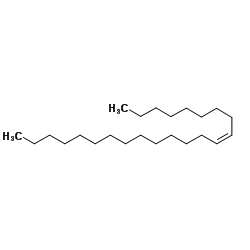(Z)-9-tricosene identified in rectal gland extracts of Bactrocera oleae males: first evidence of a male-produced female attractant in olive fruit fly.
Adriano Carpita, Angelo Canale, Andrea Raffaelli, Alessandro Saba, Giovanni Benelli, Alfio Raspi
Index: Naturwissenschaften 99(1) , 77-81, (2012)
Full Text: HTML
Abstract
It is well-known that Bactrocera oleae (olive fruit fly) females attract conspecific males by using 1,7-dioxaspiro[5,5]undecane (1) as the main component of their sex pheromone, and that 1 is produced in the female rectal gland. Although some authors have claimed that B. oleae males also attract females, to date no male-produced female attractants have been found in this species. In this paper, we report the first identification of a substance unique to males and able to attract females. The findings of the study include the following: (1) females responded in a bioassay to hexane extracts obtained from rectal glands of 15-day-old B. oleae males, (2) the presence of (Z)-9-tricosene (2) was consistently and unambiguously identified in these extracts using gas chromatography (GC) and GC-mass spectrometry methods, (3) in preliminary bioactivity tests, low doses (equivalent to a few males) of chemically and stereoisomerically pure synthetic (Z)-9-tricosene (2) attracted olive fruit fly females. Interestingly, compound 2, commonly called muscalure, is also a well-known component of the house fly (Musca domestica) sex pheromone.
Related Compounds
| Structure | Name/CAS No. | Molecular Formula | Articles |
|---|---|---|---|
 |
(9Z)-9-Tricosene
CAS:27519-02-4 |
C23H46 |
|
Field evaluation of (Z)-9-tricosene, a sex-attractant pherom...
1980-09-01 [J. Commun. Dis. 12(3) , 109-17, (1980)] |
|
Unusual mechanism of hydrocarbon formation in the housefly: ...
1994-10-11 [Proc. Natl. Acad. Sci. U. S. A. 91(21) , 10000-4, (1994)] |
|
Visual responses of Musca domestica to pheromone impregnated...
1999-05-01 [Med. Vet. Entomol. 13(2) , 132-8, (1999)] |
|
Field trials of pheromone-toxicant devices containing muscal...
1981-02-20 [J. Med. Entomol. 18(1) , 73-7, (1981)] |
|
Assessing insecticide resistance and aversion to methomyl-tr...
2004-09-01 [Pest Manag. Sci. 60(9) , 901-8, (2004)] |